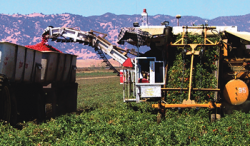
In 1942, University of California, Davis (UCD) biologist, Jack Hanna recognized the need for breeding tomato varieties that ripen uniformly and withstand the rigors of mechanical harvesting. In 1949, UCD agricultural engineer Coby Lorenzen and Hanna began developing a mechanical tomato harvester. Parallel efforts by others, notably those started in 1957 by agricultural engineer Bill Stout and horticulturist Stan Ries of Michigan State University, eventually resulted in several different harvesting mechanisms. In the late 1950s, UCD agricultural engineer Steven J. Sluka developed a vine separator for Lorenzen's machine. The modified harvester was successfully tested on the Lester Heringer farm and Heringer convinced Blackwelder Manufacturing Co. of Rio Vista, CA to commercialize the UCD design. The resulting machine became the dominant tomato harvester in the world and revolutionized the industry. Methods for harvesting processing tomatoes in the USA changed from essentially all manual in 1963 to primarily mechanical by 1968. There were great concerns about the displacement of hand labor by mechanical harvesting. However, the machines cut harvesting costs by half and led to large increases in both tomato acreage and tonnage within and eventually outside the USA.


